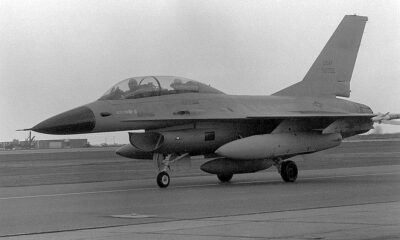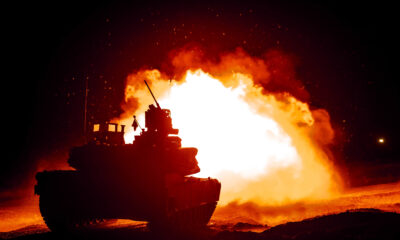Guest Columns
Turning the lights off in Iraq

Airmen of the 70th and 424th Medium Truck Detachment are on the roads in Iraq every day, cargo and other items out of the country in support of the December 31st deadline for U.S. Forces to be out of Iraq.
Only a handful of months ago, these Airmen where driving an aircrew bus or the big white bus that takes Airmen from the base exchange to the chow hall — today they’re commanding convoys, driving cargo trucks out of Iraq.
The members of this convoy are a diverse bunch. Airmen on this mission are from the 70th MTD and are on their second or third deployment to the same location, carrying out the same mission. Their partners for this mission are Soldiers of B Troop, 1-94 Cav., Pine City, Minn. Army National Guard. The Soldiers will be providing security for the convoy in the form of mine-resistant ambush-protected vehicles that are heavily armed.
Leaving Iraq: Day 1
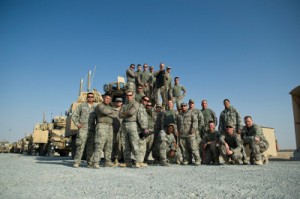
U.S. Air Force members assigned to the 70th medium truck detachment and U.S. Army Minnesota National Guard members assigned to B-Troop, 1-94 Cavalry, Pine City MN, pose for a group photo after successfully transporting equipment out of Iraq on Oct. 30, 2011. The Joint team drove more than 1,100 miles and hauled 43 truckloads of supplies and equipment out of Iraq. The 70th MTD runs the convoy operations while B-Troop provides security. (U.S. Air Force Photo/Master Sgt. Jeffrey Allen)
Hi, nice to meet you. Lets risk our lives together: After arriving at an Army camp to meet their gun truck crew for the first time, the truckers and Soldiers prepare to roll out. Though this is the first time the Airmen and Soldiers are meeting, their first journey together isn’t a short one – an eight hour drive to a Forward Operating Base Kalsu. In the staging area, the whites (nickname for the white trucks driven by the contractors) are lined up and briefed by a designated Airman. To the side, Airmen play catch with a football. In an area nearby, the Soldiers do the same. Finally, everyone is good to go, and begin their mission to haul supplies and cargo from Iraq.
Arriving at FOB Kalsu, the first leg of the mission concludes at about nine hours. As the sun comes up for the day, the Army crew settles into their cots and fall asleep. Throughout the six-night mission, the gun truck crews are early to rise as the sun is just setting, starting each day by fueling up their trucks, mounting their guns, and getting their MRAPS ready for the day. The Airmen are opposite. They are late to bed, fueling up their trucks, uploading any cargo and lining up all 35 civilian truckers who speak little or no English.
The timeline for this trip is hazy; transitioning to a nightshift schedule causes the days to blend together.
Day 2
“Yeah, I’m on fire”: Both Air Force and Army crews load up their trucks and gather in the staging area. Army Sgt. 1st Class Brian Sielski, (known as Sgt. Ski to his crew) is in charge of the gun trucks. Before each trip, Sielski and U.S. Air Force Tech. Sgt. David Perez, convoy commander and native of Santa Fe, N.M. take turns briefing the Soldiers and Airmen on the upcoming leg of the trip. This trip will take the convoy through several high threat areas, Sielski says in his brief as he goes over intelligence reports and security tactics. Perez goes on to brief the troops on procedures if there’s an attack on the convoy, communication protocol, and other relevant information.
Though the trip from the starting location to Kalsu was double the miles of today’s trip to Joint Base Balad both trips took a similar amount of time.
“Smokey-Boz,” says Air Force Staff Sgt. William Clarkson (known as Boz to his crew), a truck commander and native of Auburn, Calif., over the intercom system during the convoy.
“This is Smokey — send it,” replies Perez.
“I have smoke in the cabin,” says Clarkson.
About five seconds go by and a monotone Clarkson comes over the intercom system, “Yeah, I’m on fire.”
A pause is observed over the radio as if there’s disbelief of what was just said so casually.
Clarkson’s truck has issues with its engine , giving him having a front row seat to a light show as flames are spewed out of the passenger-side exhaust.
“All I remember is seeing flames coming up my side, yelling at (Airman 1st Class Tyler )Bartlett to pull over,” recalls Clarkson. Reacting quickly, Clarkson pushed Bartlette out of the driver door, and followed him out. “As soon as we stopped, I drop kicked him out of the truck and jumped out of his side.”
As if a vehicle catching on fire isn’t dangerous enough, the area the convoy is stopped in has a track record for an above-average amount of enemy activity. Adrenaline starts pumping through the veins of each member in the gun truck. The threat posed to the stopped, two-mile long convoy, sharpens the senses of every gunner as they constantly scan for threats.
“As soon as we heard (Clarkson) casually say he’s on fire, I sent a gun truck to his location,” said Sielski. Within minutes, the fire is out.
As the mechanics and other truckers get the crispy, burnt truck ready to move via a tow system, the gun trucks keep traffic back and the area as secure as possible. Throughout the ordeal, everyone worked together as if they had been a team for years. Everyone did what they were supposed to and it lead to a quick, safe pause in the mission.
The convoy pushes through, and continues on their way to JB Balad when another curve ball is thrown.
Sielski tells Perez that their mission has been changed. The mission for this trip was supposed to take the convoy to JBB to upload cargo then back. The convoy finds out that they are now only supposed to stop at JB Balad for the night, then proceed north to FOB Warrior to upload MRAPs, then push back to JBB to load the remaining trucks. The unforeseen change added an additional two days to the mission.
Finally, after another long day on the road, the convoy arrives at JBB as the sun begins to rise. The Soldiers again secure a place for everyone to stay as the truckers stage the trucks for the next day.
Day 3
An added threat: As everyone gathers up, something huge stands out to the crew about JBB — the emptiness. Only months ago, JBB had a reputation of having one of the best dining facilities in the country. Now, food is served in little plastic bags called Meals, Ready to Eat. The place is a ghost town. Even the truck staging area is empty with the exception of the convoy’s trucks and a crane sitting by itself, with nothing to load. The artwork on the bathroom stalls tell the story of members who are on their way out as most stalls are signed by troops and end with a “finally going home.”
The convoy prepares to hit the road. Sielski and Perez give their briefs then Air Force Staff Sgt. Brandon Dejarnette (better known as De Jay), assistant convoy commander and native of Phoenix, Az., huddles everyone up and says a prayer, which is said before every leg of the trip. Religious or not, many take part. His words echo something that most deployed members can relate to — “keep us safe, and look out for our families. Help us not to be complacent.”
As everyone makes their way to the trucks, the gun trucks take part in a pre-mission routine — “Lord, have mercy on my enemies, because I will not,” says Sielski as each gun truck member toast with an energy drink which is consumed within seconds.
“AHH! Why do we do this?” exclaims U.S. Army Specialist Patrick Eaton, a gunner with the gun trucks, as the strong bite of the energy drink serves a look of shared displeasure to everyone’s face. Yet, this routine is done before every leg of the trip, just like the prayer.
“If it’s not broken, don’t fix it,” says Sielski.
The convoy doesn’t fully make its way out of the gate of JB Balad and there’s already an incident — a white truck’s driver-side window is shattered from a rock thrown by a group of local Iraqi boys.
Making their way throughout the city of Tikrit, tension is high. The roads the convoy are on border buildings with possible threats every inch of the way. Gunners constantly scan for roadside bombs and hostile people. Their spotlight cuts through the seemingly infinite amount of darkness.
With only minor incidents to report, the convoy arrives at FOB Warrior.
Though the trip is finished, going to bed is still hours away. Waiting is something every member in the convoy has mastered. Though the convoy was directed to go to FOB Warrior, it appears as though their arrival was not expected by the members of FOB Warrior. Hours pass by before the truckers finally find where their cargo is, and before the Soldiers find a place for the convoy to sleep — a basketball gym where blue workout mats are used as mattresses. The sleeping quarters serve as a testament to the lack of convoys this FOB sees.
A worker in the loading dock comments, saying they haven’t seen a convoy in their area in weeks as U.S. military forces withdraw from Iraq. Everyone in the convoy believes it.
Day 4
Not a typical alarm clock: Waking up to a gym full of sleeping Soldiers and Airmen is almost comical. Woven between workout equipment, a Solider sleeps on his blue mat with his .50 caliber machine gun next to him. Only hours after the last group of Airmen fall asleep a siren goes off “rocket attack, rocket attack, rocket attack.” A nice wakeup after two hours of sleep. Even when the convoy is off the road, danger is all around them. The alarm sounded multiple times including on the way out of the gate.
Heading back to the convoy’s original destination of JB Balad, travel isn’t so smooth. A contractor’s vehicle has two tires go flat..
Any time the convoy halts, breaths are held.
Gunners scan the area for any possible threats as the convoy’s mechanic, U.S. Air Force Senior Airman Christopher Barton, a native of Las Vegas, Nev., goes boots on ground to change the tires. An hour later, both tires are changed and the convoy is moving again.
Only miles from JB Balad, a convoy passes from the opposite direction. Each vehicle has several cracked windows.. The dented up passing vehicles serve as a reminder to be vigilant..
Every halt, children approach the convoy.
“What’s in their hands, E,” U.S. Army Sgt. Arthur Wemhoff, rear gun truck commander, shouts to his gunner, Eaton, wanting to make sure the children aren’t preparing to throw rocks.
Finally, the convoy makes its way through the gates and everyone can breathe again. Though the truckers uploaded a few trucks at FOB Warrior, JB Balad is where a majority of their trucks will be loaded. Nearly six hours go by from arrival until the last truck is loaded and the truckers can go to bed.
Day 5
Bonds are formed: As the convoy hits the road again, many members are looking forward to their first hot meal of the day and eating something other than a Pop Tart — the popular standard issued snack.
Once out the gate, travel is relatively painless with the exception of a few dozen Iraqi checkpoints, which forces the convoy to slow down then speed up like an accordion.
After arrival at FOB Kalsu, everyone gets to the tents around the same time — a first for the convoy.
Tired, troops throw their bags on the cots and get ready for bed. Soldiers are mixed in with Airmen. The cots are so close together, you can barely fit a tennis shoe between them. Perez chooses the first cot near the front, like a mother bear protecting her cubs.
After five nights together, this convoy of Airmen and Soldiers are operating together like one team. “When we get back, I want to figure out a way for us to work exclusively with this group,” said Sielski to a few of his Soldiers during dinner (which is breakfast time for most.) “These guys have their (stuff) together.”
Day 6
A team born in six nights: Finally, the last day. Talks of clean laundry and watching Sunday night football fill the air.
An hour delay is made as the weather is questionable and should pass soon. Though on day one, each service played football on their own, today an Airmen is passing the ball to a Soldier as the football field of gravel is lit up by the trucks. Another Airman plays the role of disc jockey, and blasts music out of his loud speaker. The DJ plays a request from a Soldier and begins to dance to LMFAO’s top hit — Party Rock Anthem, doing the song’s signature dance called the shuffle in his full body armor. Everyone is smiling and cheer him on.
Then the call is made to mount up. Smiles turn to game faces. Briefs are made, De Jay says the prayer, the gun trucks take part in their energy drink chug joined by Clarkson and Bartlett, and Sielski makes his speech.
After an eight hour trip, the convoy makes it back to an undisclosed location in Southwest Asia where they first met only six days ago. A final sigh of relief can be made as this road trip is over. The convoy is outside of the combat zone.
Perez gathers all the troops, and gives an after action report. Feedback is given by both sides.
“You guys have been the best we’ve worked with,” said Sielski for the first time to the entire group. “If we can be with you guys every mission, then let’s figure it out.”
As the AAR breaks up, email addresses are passed between Airmen and Soldiers.
“Look me up on Facebook,” said an Airman to a Soldier.
About 1,100 miles were covered in six nights. More than 250,000 lbs of cargo was pulled out on this mission.
In fact, if a C-130 Hercules had to move the amount of cargo the truckers have since November 2005, it would have taken more than 6,600 sorties to get it done.
With about half of this convoy being 21-years-old or younger, some of these young warriors may not realize that they are part of history. After eight years of war, more than 3,000 lives lost, this group of Airmen, Soldiers and many like them are turning off the lights in Iraq.
This article first appeared today (November 11, 2011) at US Air Forces Central.
-
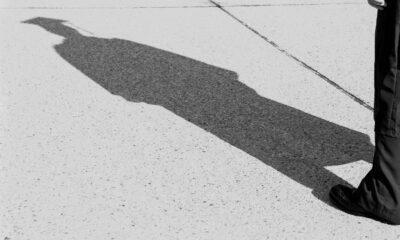
 Education4 days ago
Education4 days ago‘Grading for Equity’: Promoting Students by Banning Grades of Zero and Leaving No Class Cut-Ups Behind
-

 Education2 days ago
Education2 days agoCHAPTER 11: Critical Race Theory: A Species of the Ideological Thought Genus Marxism
Space Is No Longer the Final Frontier—Reality Is [forthcoming release May 2024] -

 Family4 days ago
Family4 days agoIdaho defends against abortion mandate
-

 Constitution3 days ago
Constitution3 days agoPresidential immunity question goes to SCOTUS
-

 Civilization1 day ago
Civilization1 day agoWill Trump flip New York?
-

 Clergy2 days ago
Clergy2 days agoHistorical Points Have Their Place, But That Is Not Where Your Faith Is To Stand!
-
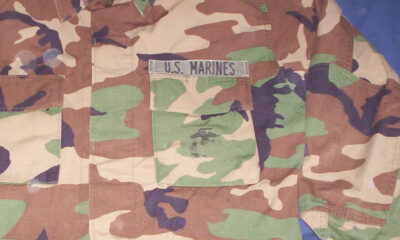
 Civilization3 days ago
Civilization3 days agoMarine Corps Force Design: In Defense of Chowder II
-
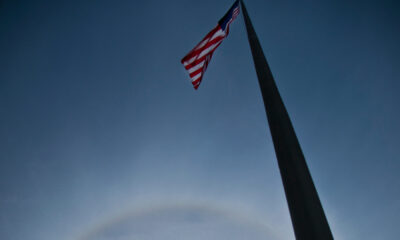
 Guest Columns3 days ago
Guest Columns3 days agoAn Ugly Win


